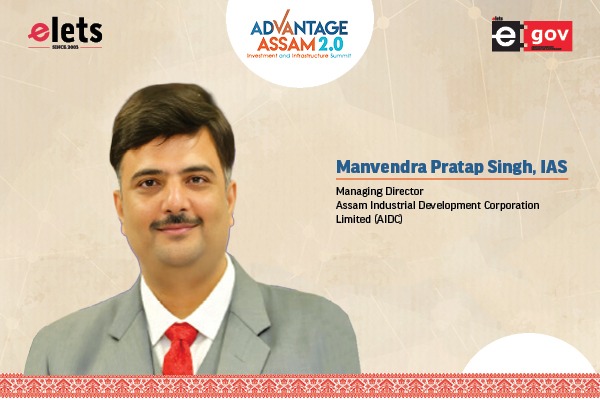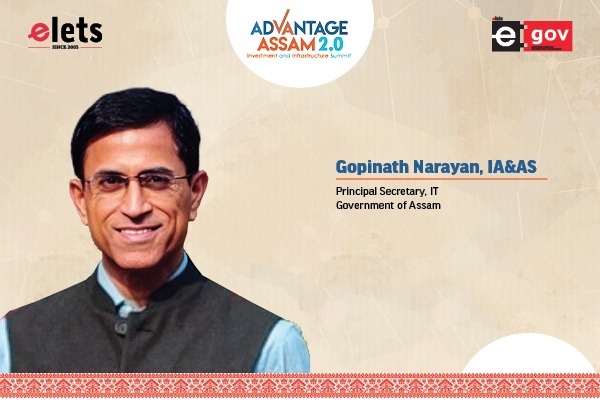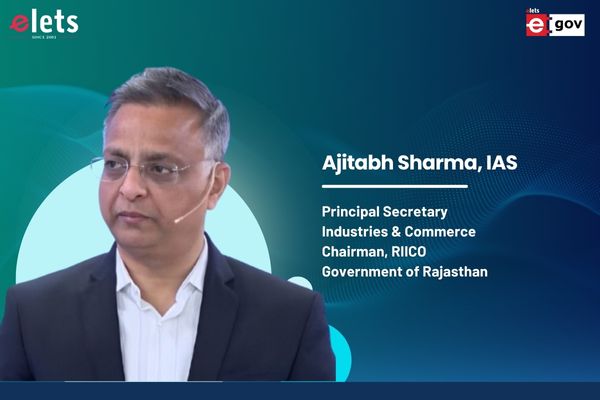
With a focus on achieving India’s trillion-dollar digital economy goal, Karnataka’s strategies are paving the way for significant advancements in various industries. In an exclusive interview with Elets News Network (ENN), Darshan H.V, IAS, Director – Department of Electronics and Information Technology, Biotechnology and Science & Technology and Managing Director – KITS, Government of Karnataka delves into Karnataka’s ambitious policies driving sectors like IT, biotech, and service delivery integration. Edited Excerpts:
The Karnataka IT Policy 2020-2025 aims for the state’s IT industry to contribute approximately 30% to India’s trilliondollar digital economy goal. What specific strategies and initiatives are being implemented to achieve this significant contribution, and how do you measure progress towards this target?

The Karnataka IT Policy 2020-2025 is a visionary document that sets forth a strategic framework to enable the state’s IT industry to contribute approximately 30% to India’s trillion-dollar digital economy goal. The policy encompasses a range of strategies and initiatives that are meticulously designed to address various aspects of the IT ecosystem, from infrastructure and talent development to innovation and global competitiveness.

One of the cornerstone strategies of the policy is the development of robust infrastructure to facilitate the growth of the IT industry. This includes the establishment of IT hubs in different districts to promote balanced regional growth and alleviate the burden on metropolitan areas like Bengaluru. The creation and enhancement of technology parks to international standards and the provision of high-speed internet connectivity across the state, particularly in rural areas, are also pivotal to the policy’s infrastructure development goals.

Talent development and nurturing form another critical aspect of the policy. With an understanding that a skilled workforce is essential for the IT industry’s success, the policy advocates for educational reforms and industry- academia collaborations to ensure that graduates are equipped with the necessary skills. Additionally, the policy introduces skill development programs to upskill the existing workforce in emerging technologies such as AI, ML, and blockchain, while also promoting innovation and entrepreneurship through the establishment of innovation hubs and incubation centres. The policy also places a strong emphasis on the promotion of emerging technologies by setting up Centers of Excellence in key areas like Artificial Intelligence, the Internet of Things (IoT), and Cybersecurity. These centres aim to drive research and development, while financial incentives, mentorship, and incubation support are provided to startups specialising in advanced technology domains.

To enhance Karnataka’s global IT footprint, the policy outlines initiatives such as forming Global Innovation Alliances with leading technology hubs worldwide and engaging in international marketing efforts to attract foreign investment and showcase the state’s IT capabilities. Supportive measures, including financial incentives, tax exemptions, and the simplification of regulatory processes, are also part of the policy to stimulate industry growth and make it easier for IT companies to establish and expand their operations in Karnataka.
To ensure that these ambitious strategies translate into tangible outcomes, the policy includes mechanisms to measure progress towards the 30% contribution target. Key Performance Indicators (KPIs) have been established to track advancements in infrastructure, talent enhancement, and economic contributions. Regular reviews and reports will assess the effectiveness of the strategies, and stakeholder feedback will be sought to refine the policy and initiatives as needed.
The Karnataka IT Policy 2020-2025 presents a comprehensive and multi-faceted approach to bolstering the state’s IT industry. Through the diligent implementation of its strategies and the ongoing evaluation of progress, Karnataka is poised to play a significant role in realising India’s vision of a trillion-dollar digital economy.
The biotech sector in Karnataka is poised for significant growth, with projections indicating a substantial increase in market size by 2025. Could you elaborate on the key policy initiatives and strategic measures undertaken by the state government to foster such exponential growth?
To sustain the growth of Karnataka’s biotech industry and maintain its status as a preferred destination for biotech investments, the government typically employs several strategies as below:
- Developing biotech parks, incubation centres, and research facilities: Providing cutting-edge infrastructure for biotech companies and startups, ensuring access to advanced laboratories, equipment, and technology platforms.
- Providing policy frameworks: Supporting biotech research, development, and commercialization through tax incentives, subsidies, grants, and regulatory reforms aimed at streamlining processes.
- Stimulating innovation and R&D in biotechnology: Offering grants, funding initiatives, and partnerships with academic institutions and research organisations to foster new discoveries and technologies.
- Strengthening the skill set of the biotech workforce: Implementing targeted training programs, collaborations with educational institutions, and initiatives designed to attract and retain talent in the sector.
- Facilitating collaboration between biotech firms and academic institutions: Encouraging joint research ventures, technology transfer, and the exchange of knowledge to drive advancements in the field.
- Supporting biotech startups: Providing incubation facilities, seed funding, mentorship programs, and networking opportunities to cultivate an environment conducive to innovation and entrepreneurship.
- Promoting Karnataka’s biotech capabilities globally: Forging partnerships with international biotech firms and participating in global conferences and events to attract foreign investments and collaborations.
- Encouraging the adoption of environmentally sustainable practices: Aligning biotech manufacturing and processes with global standards and certifications to minimise ecological impact.
- Fostering public-private partnerships (PPP): Jointly investing in biotech projects, infrastructure development, and capacity-building initiatives to leverage resources and expertise for sector growth.
- Implementing robust monitoring and evaluation mechanisms: Tracking biotech sector growth through comprehensive data collection, impact assessments, and feedback loops to refine policies and strategies accordingly.
The Karnataka Government endeavours to cultivate an environment supportive of the biotech industry, nurturing innovation, stimulating economic growth, and generating employment within the state. These initiatives are pivotal in maintaining Karnataka’s forefront position in India’s biotech sector and in attracting additional investments into the industry.
Could you elaborate on the integration process of Seva Sindhu with various service delivery channels like Grama One, Janasevaka, Karnataka One, and Bangalore One? How has this integration contributed to streamlining service delivery and reducing redundancy in administrative processes?
Seva Sindhu is an initiative by the Government of Karnataka aimed at providing various government services to citizens through a single window. The integration of Seva Sindhu with other service delivery channels, such as Grama One, Janasevaka, Karnataka One, and Bangalore One, has significantly contributed to streamlining service delivery and reducing redundancy in administrative processes in Karnataka:
- Single Window Portal: Seva Sindhu acts as a single window portal where citizens can access a wide range of government services. By integrating with other service delivery channels, Seva Sindhu consolidates these services into one platform, making it easier for citizens to find and avail themselves of the services they need without navigating multiple portals or physical offices.
- Improved Access and Convenience: Integration with Grama One, Janasevaka, Karnataka One, and Bangalore One means that citizens can access government services through multiple touchpoints such as online portals, service centres, and mobile apps. This improves accessibility and convenience, as citizens can choose the channel that best suits their needs or preferences.
- Reduction of Redundancy: Before the integration, different departments or agencies may have had separate portals or processes for service delivery, leading to redundancy in administrative efforts and potential confusion for citizens. Integration through Seva Sindhu centralises these processes, reducing duplication of administrative tasks and promoting efficiency.
- Enhanced Service Monitoring and Feedback: Centralised integration allows for better monitoring of service delivery metrics and citizen feedback. Government agencies can track the performance of services more effectively across different channels, identify bottlenecks or areas for improvement, and respond to citizen feedback promptly.
- Cost Savings and Resource Optimisation: By streamlining administrative processes and reducing redundancy, integration through Seva Sindhu helps in optimising resources and reducing operational costs for the government. This efficiency allows agencies to allocate resources more effectively towards improving service quality and expanding service offerings.
- Unified Citizen Experience: Perhaps most importantly, integration contributes to a unified citizen experience. Citizens benefit from a consistent interface, standardised processes, and simplified access to government services, regardless of which channel they choose to use. This improves overall satisfaction and trust in government services.
In summary, the integration of Seva Sindhu with various service delivery channels in Karnataka has played a crucial role in transforming service delivery by promoting efficiency, reducing redundancy, improving access, and enhancing the overall citizen experience. It represents a significant step towards achieving the goal of digital governance and citizen- centric service delivery in the state.
How does Karnataka’s Data Centre Policy 2022 contribute to positioning the state as a prominent centre for data infrastructure, aligning with India’s goal of achieving a USD 1 trillion digital economy by 2025?
The Karnataka Data Centre Policy 2022 is a strategic initiative aimed at transforming Karnataka into a leading hub for data infrastructure, significantly contributing to India’s vision of a USD 1 trillion digital economy by 2025.
This comprehensive policy encompasses various incentives and support mechanisms to attract substantial investments and foster the growth of the data centre industry in the state.
Karnataka has long been recognised as a technology and innovation powerhouse. The Data Centre Policy 2022 builds on this legacy by targeting investments worth Rs 10,000 crore by 2025, setting a robust foundation for data infrastructure development. The policy’s key components include offering a slew of incentives such as capital subsidies, electricity duty exemptions, and land purchase subsidies. These measures are designed to make Karnataka a preferred destination for data centre operators and investors.
Also Read | Karnataka: Leading India’s Biotech Boom with Innovation and Investment
One of the notable aspects of the policy is the capital subsidy of up to 7% on the value of fixed assets, excluding land and building costs, with a maximum cap of Rs 10 crore. Additionally, a 100% exemption from electricity duty for the first five years is provided, significantly reducing operational costs for data centre operators. The policy also offers a 10% subsidy on land purchase or lease costs, up to a maximum of Rs 3 crore.
The state’s strategic location and existing infrastructure play a crucial role in its appeal. Karnataka, particularly Bengaluru, already hosts several major data centre players, including Reliance, Sify, NTT, Next Gen, Trimax, Airtel, STT, and ESDS. With this policy, the state aims to increase its data centre capacity to over 200 MW, enhancing its share of India’s data centre capacity.
Moreover, Karnataka’s Data Centre Policy 2022 aligns with broader national objectives by supporting the Digital India initiative. By fostering a conducive environment for data centres, the state not only aims to boost its digital economy but also supports the creation of high-value jobs, enhances data sovereignty, and provides critical infrastructure for emerging technologies like AI, IoT, and big data analytics. This infrastructure is vital for supporting various sectors, including finance, healthcare, and education, thereby driving comprehensive economic growth.
It is a forward-thinking initiative that leverages the state’s technological prowess and strategic advantages. By attracting significant investments and fostering a robust data infrastructure ecosystem, Karnataka is poised to play a pivotal role in achieving India’s ambitious digital economy targets. The policy not only underscores the state’s commitment to innovation and growth but also its strategic vision to become a global leader in data infrastructure.
Could you elaborate on the strategies you would employ to further enhance Karnataka’s position as a prominent player in the electronics manufacturing sector, considering its current standing as the 4th largest manufacturer in India and the presence of over 300 export-oriented units?
Karnataka is a frontrunner in India’s electronics growth story. The state is currently the most innovative in India, with the highest share of the most innovative companies (46% of the national share). Contributing to 10% of India’s industrial output, Karnataka has also been a top state in terms of electronic exports, currently exporting USD 4.52 billion worth of electronics, ranking 3rd in the country. The position that Karnataka holds in India’s electronics landscape is a result of decades of development and the trajectory that Karnataka has been on in the IT and electronics sector. Karnataka is the birthplace of innovation, information technology, R&D, and manufacturing in India.
Being at the forefront of India’s electronics ecosystem development journey, it is crucial to retain the position the state has achieved and focus on only propelling it further, led by innovation. Karnataka witnesses cutting-edge R&D activities conducted by companies such as Texas Instruments, GE, Intel, Samsung, Siemens, Qualcomm, Applied Materials, etc., and it is the first choice of many electronics manufacturing companies which have set up their businesses here. GE has its world’s 2nd largest R&D centre in Karnataka. The state also houses Intel’s largest R&D centre outside the United States of America. Karnataka is already home to many companies in automobile manufacturing, medical devices manufacturing, aerospace and defence, consumer electronics, heavy electrical machinery, such as Tata, Toyota, AT&S, Scania, GE Healthcare, Siemens, Volvo, Bosch, Hon Hai Technology Group, among others.
To facilitate, promote, and develop Karnataka’s ESDM sector, the Karnataka ESDM Policy was amended and released in 2017. This policy provides a combination of promotional incentives, post-performance incentives, fiscal measures, capital subsidies, and other capacity-building measures, with a core objective to promote companies to increase their domestic value addition. The state further analysed its position in India’s electronics value chain and understood that while the manufacturing of electronic components (ICs, insulators, wires and cables, accessories, and electronic sub-assemblies) and technology development for high- value-added products were witnessed in the state, Karnataka wanted to leverage this opportunity to also attract Tier 1 manufacturing, Original Equipment Manufacturers (OEMs), and Lead Firms. Hence, in order to provide the much-needed fiscal interventions that will bring a fillip to the ESDM sector, GoK announced the Special Incentives Scheme for the ESDM Sector in September 2020.
The Government of Karnataka has set up various Centers of Excellence (CoEs) across the state to boost accelerator support to the startup ecosystem and drive innovation. The state has CoEs in the fields of aerospace and defence, cybersecurity, animation and gaming, artificial intelligence, IoT, machine intelligence and robotics, etc. Going forward, Karnataka shall continue to implement its incentive-driven policies in the state, prepare its CoEs to promote innovation, and be at the forefront of promoting its lucrative ecosystem on national and international platforms. A special focus will be provided on creating innovative solutions around industry-level issues such as the requirement of a skilled talent pool to cater to the upcoming specialised value chain activities in electronics and semiconductor manufacturing.
Given Karnataka’s prominent position in chip design, with 85 fabless chip design houses, how can the state strategically capitalise on this strength to fuel innovation and entice additional investment into its electronics industry?
Karnataka is home to 400+ Research & Development centres and 85+ chip designing centres like Texas Instruments, GE, Intel, Samsung, Siemens, Qualcomm, Applied Materials, Lam Research, Micron Technology, etc. GE has its world’s 2nd largest R&D centre in Karnataka. The state also houses Intel’s largest R&D centre outside the United States of America. Further, in 2018, the Government of Karnataka set up a Semiconductor Fabless CoE in collaboration with IESA-Semiconductor Fabless Accelerator Lab (SFAL). This CoE provides Indian fabless semiconductor product companies with easier access to R&D infrastructure like EDA tools, design IPs, foundry access, etc., enabling them to successfully design and develop product prototypes.
To strategically capitalise on this strength of the state in chip designing and critical ER&D activities in the semiconductor manufacturing value chain, the state is working towards efficiently implementing its strategic interventions across three pillars: policy ecosystem enhancement, infrastructure development, and skill enhancement and upgradation. For instance, the state will potentially amend its ESDM policy soon given that the existing policies may witness their policy period end. For this, various stakeholder consultations have started to ensure that the new policy in the future continues to be aligned with the key enablers required by semiconductor and overall electronics companies. Additionally, for the development of conducive infrastructure, the state is working towards developing four Electronics Manufacturing Clusters – Kotur Belur in Dharwad district, Kochanahalli in Mysuru, Adinarayanahosahalli in Bengaluru Rural district, and Vasantanarasapura in Tumakuru district. Similarly, many innovative plans are also being discussed and finalised in the space of setting up CoEs.
Be a part of Elets Collaborative Initiatives. Join Us for Upcoming Events and explore business opportunities. Like us on Facebook , connect with us on LinkedIn and follow us on Twitter, Instagram.
"Exciting news! Elets technomedia is now on WhatsApp Channels Subscribe today by clicking the link and stay updated with the latest insights!" Click here!













